DEP Presents Tunnel Proposal To Gowanus Canal CAG
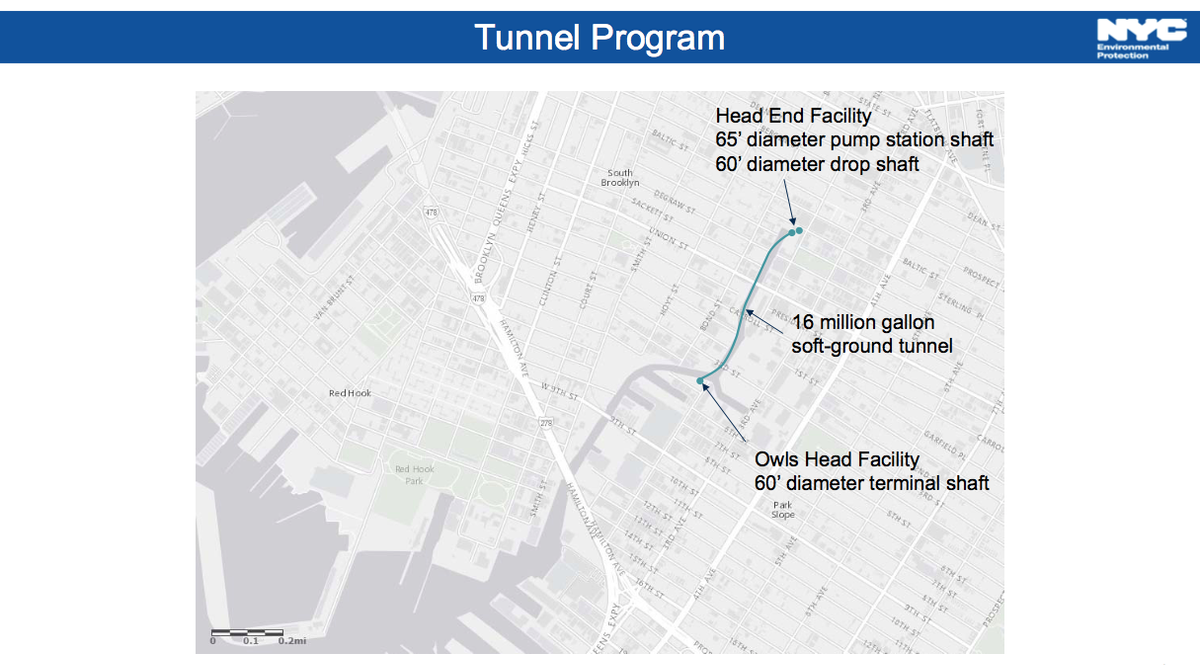
GOWANUS – The Gowanus Canal Community Advisory Group’s (CAG) monthly meeting took place as scheduled Tuesday (January 22) despite the ongoing federal government shutdown prohibiting furloughed EPA team members from attending.

CAG member Brad Vogel volunteered to fill in for EPA’s Doug Sarno who typically facilitates the meetings.
“Thank you all for being here tonight. I know it has been a little bit difficult getting things together with the government shutdown underway, but I think everyone here agrees that continuing the work of the CAG and continuing the work of the cleanup is of that much importance that it was really crucial that we continue tonight,” Vogel said before Kevin Clarke of the NYC Department of Environmental Protection (DEP) presented his agency’s tunnel proposal. DEP first announced the tunnel plan in November as an alternative to the two CSO tanks currently planned in the EPA’s Superfund cleanup of the Gowanus Canal.
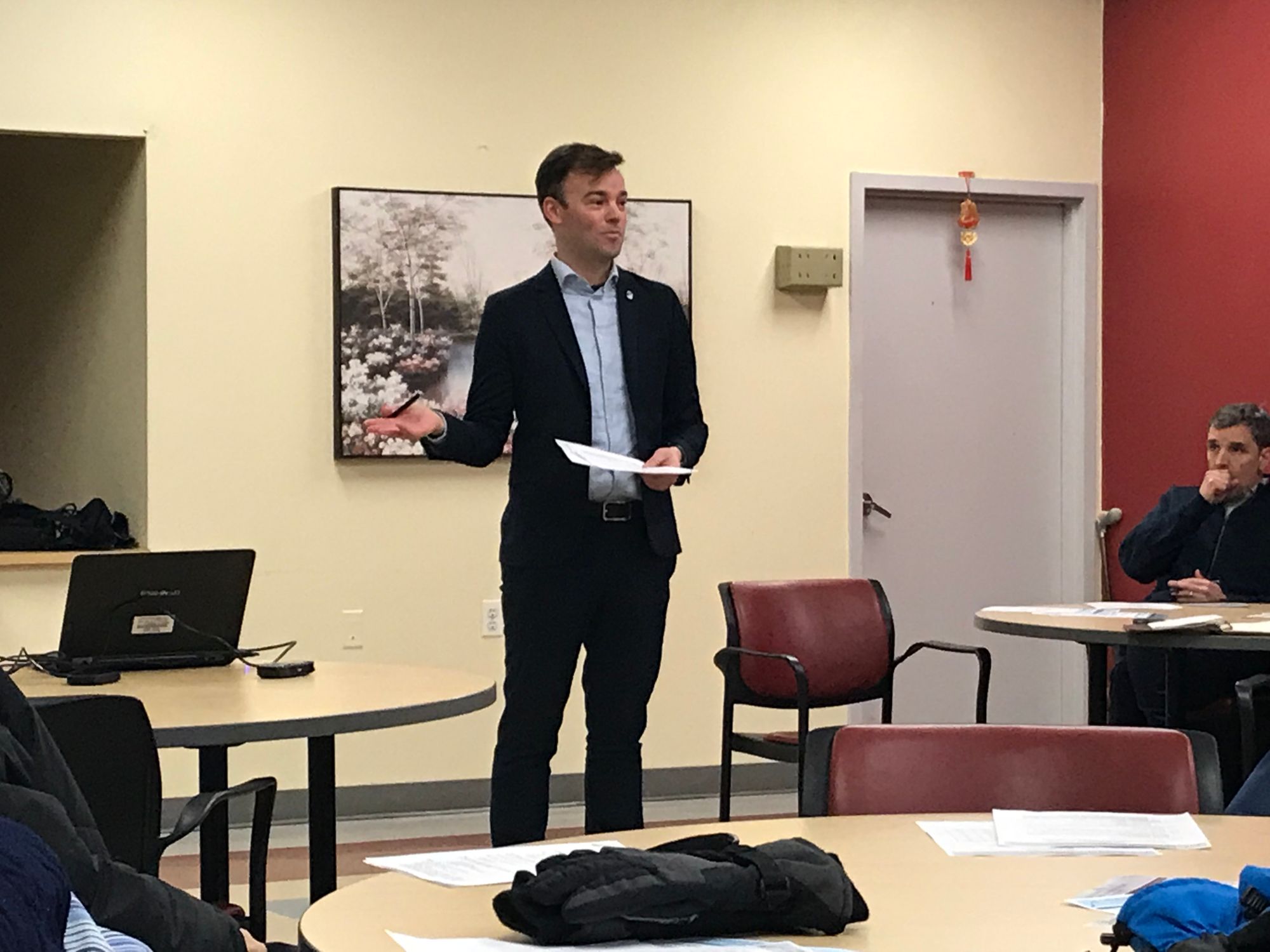
DEP is responsible for developing two CSO tanks as part of the cleanup—an 8 million gallon tank at the head end of the site at Butler and Nevins Streets (also know as the Red Hook site or RH-034) and a 4 million gallon tank mid-canal by the Fourth Street Basin (the Owl’s Head site or OH-007). In October, DEP presented to Community Board 6 its revised design for the head end of the project site which includes the 8 million gallon underground tank, the head house facility, and 1.6 acres of open space. A design for the Owl’s Head site has not been released yet.
As DEP engineers and planners were implementing tunnels to address storm and combined sewer overflow (CSO) in Flushing Bay and Newtown Creek, they decided to consider one for Gowanus as well, Clarke explained. “While we were looking at tunnels in those programs, it occurred to us maybe it makes sense to look at a tunnel for the Gowanus Canal,” he said.
The tunnel would serve the same Superfund requirements as the two tanks—reduce CSO and reduce solids in the water.
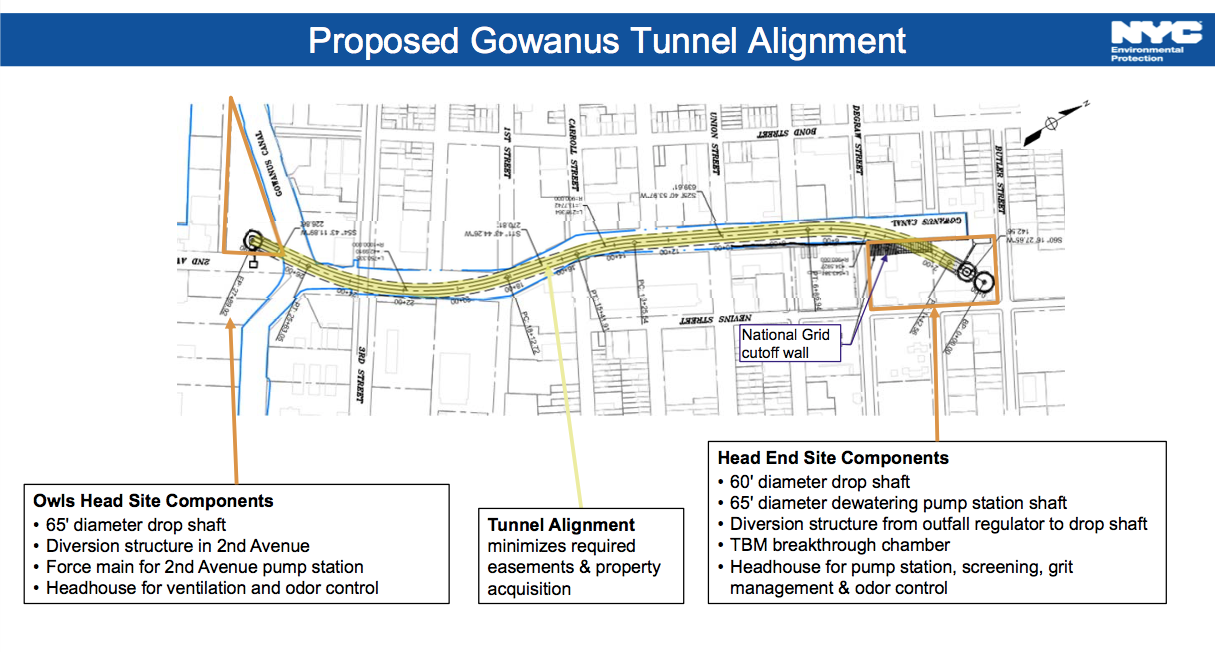
The agency is recommending the construction of a half mile tunnel under the Gowanus Canal in lieu of the two tanks. “Basically what we are proposing is a 16M gallon soft-ground tunnel that would start at the head end site, follow the alignment of the Canal, and end up at the OH-007 site,” Clarke said. A soft-ground tunnel is constructed in silt, sand, clay. The Gowanus Canal Flushing Tunnel, built over 100 years ago, is an example of a soft-ground tunnel. Clarke insisted that these types of tunnels are being constructed all over the world and compared the Gowanus project to the DC Clean Rivers Project and the Thames Tideway in London.
How would the tunnel be built?
Geo-technical and environmental studies would be conducted to determine the level of coal tar contamination at the depth of the tunnel as well as determine what type of boring machine will be used to dig the tunnel (an earth pressure balance machine or a slurry pressure balance machine).
Crews would first construct a pumping station and a figure-eight-shaped shaft at the head end site. After the shafts are constructed, the tunnel boring machine will be lowered down and dig towards the Owl’s Head site, following the alignment of the canal and removing material along its way. The boring machine would exit from a 60- to 65-foot diameter shaft constructed at the Owl’s Head end.
The tunnel would be roughly 125 to 150 feet below the surface, becoming shallower as it heads towards Owl’s Head. The tunnel will slope down towards the head end site to send the flow in that direction when de-watering the tunnel so that water can be pumped out from the Red Hook site. Clarke also noted that the tunnel will be approximately 50 to 60 feet below the National Grid barrier wall at the northern end of the canal.
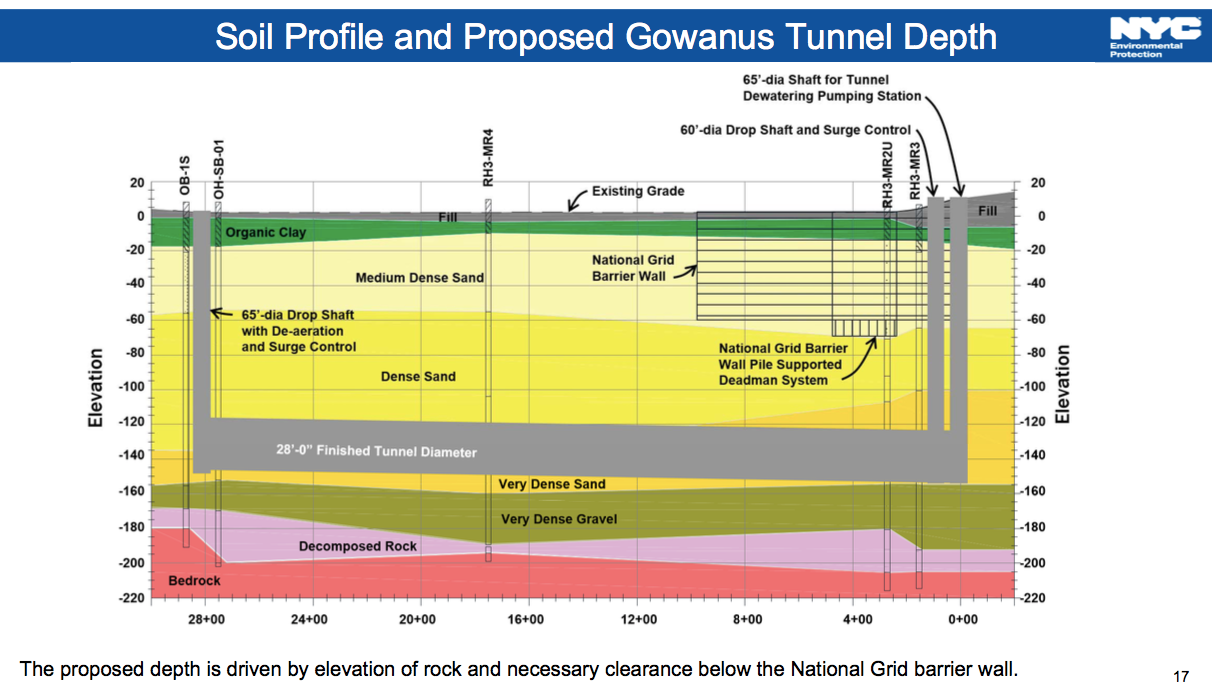
The tunnel staging area will require a smaller footprint than the tank construction staging at both sites, according to Clarke. After the shafts are constructed, most of the work will take place below ground. He notes that an above-ground facility will need to be constructed at the northern end to house the electro-mechanical equipment that will run the water pumping station and the odor control facility. It will be similar in size to the head house proposed for the 8 million gallon underground tank. The Owl’s Head site would also require a smaller footprint, requiring a facility only for venting and odor control systems.
Based on a Zone of Influence of Settlement study, land surrounding the canal will be minimally impacted, according to Clarke. “That’s another reason why we’re selecting the alignment of the canal. The canal cap is soft, it’s clay, it wouldn’t be impacted by settlement. We’re estimating half an inch or less.” Foundations on the edge of canal such as bulkheads “are out of limits of [the] zone of influence” and should not be impacted.
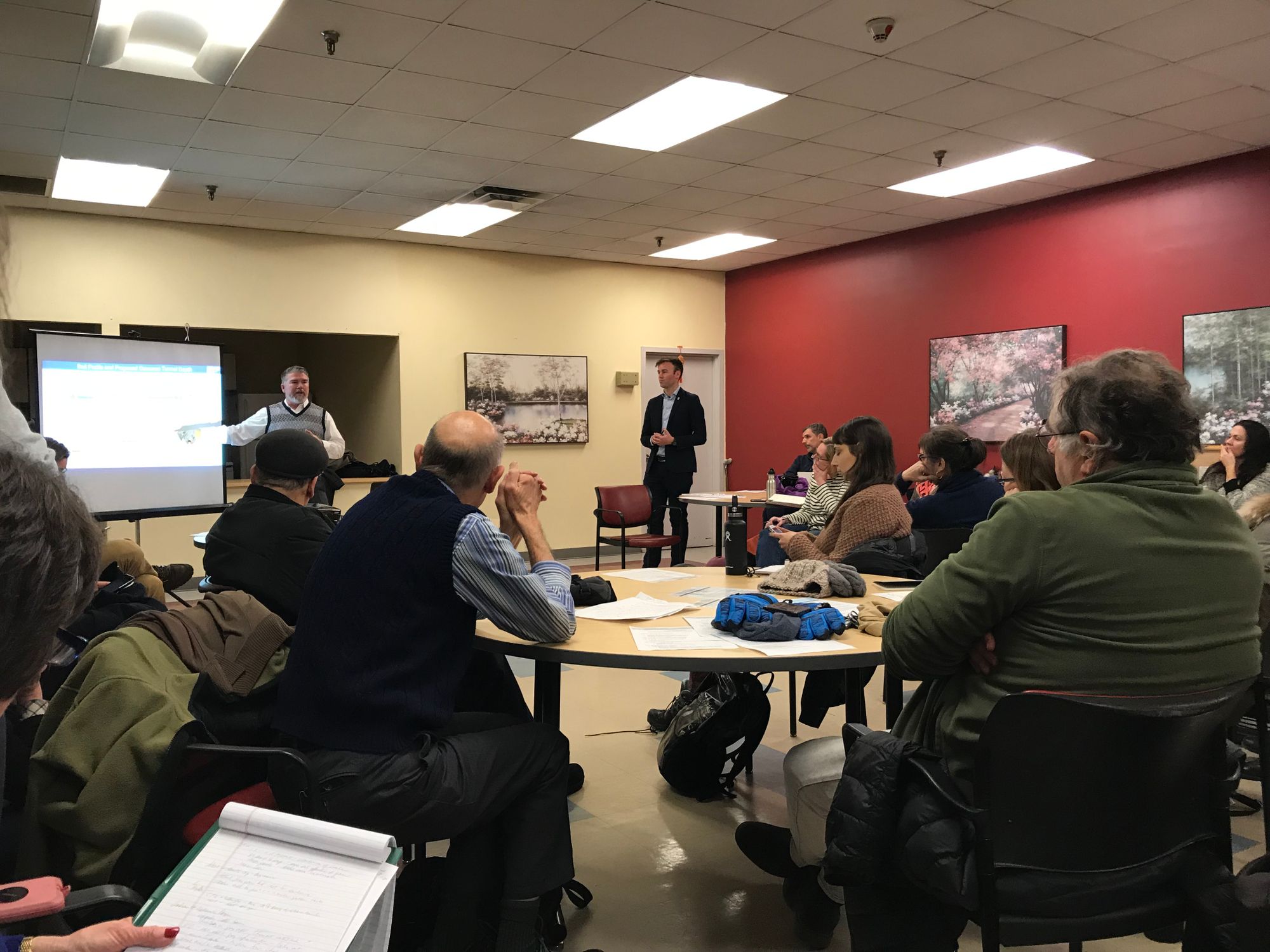
Benefits of the tunnel:
An increased storage capacity – DEP is proposing a minimum 16 million gallon storage tunnel—4 million gallons more than the combined capacity of the 8 million and 4 million gallon tanks. Clarke explained that this tunnel “upsizing” would maintain the CSO tanks’ 90% solids reduction.
A reduction in the annual CSO events into the canal – The RH-034 outfall would have about six discharges a year with the tanks. The tunnel would reduce that to only four at the Red Hook site and reduce it at the Owl’s Head site from four events per year down to zero, according to Clarke.
Less disruption to the neighborhood – With much of the construction happening below ground, there will be a reduction in noise, dust, and visible equipment.
More flexibility for public open space – “We do believe that the head house associated with the tunnel would be about the same size as the head house required for the tank at the Red Hook site, but there will no longer be a below-ground facility under the public space so that we can be more flexible with the design of that open space,” Clarke explained.
No additional property acquisition required – The property acquisitions for the Red Hook site, 243 Butler Street, 242 and 270 Nevins, were completed via eminent domain last October.
Similar cost – The CSO tanks project is estimated at $1.2 billion while the tunnel project is currently estimated at $50 million more than that. The operation costs would also be comparable, according to Clarke.
Similar implementation timeframe – “We believe that we can have the tunnel constructed by the end of 2030—that is a little bit later than both the RH and OH tanks. The head end tank we’re showing end of 2029 right now, that’s our current schedule. And the Owl’s Head tank is mid-2030. Although the tunnel is going to take a little longer, we believe that that additional time is outweighed by the additional benefits the tunnel provides,” Clarke said.
Much of the work already completed for the tank program can be leveraged for the tunnel, helping the alternative project stay close to the schedule, according to Clarke.
“The schedule that we put forth for completing the tunnel program is aggressive, but on the planning and design side of things, there’s a lot of work that’s already been completed…for the tank that’s applicable to the tunnel,” he explained.
The ULURP for the head end of the site and the property acquisition have been completed as well as the Environmental Impact Statement (EIS), with potentially only a supplemental EIS being required if the plans switch to the tunnel, Clarke explained. “All three of those items are typically long-lead items for us. It takes a long time to get those done. Those are pretty much of out the way,” he noted.
The design and planning of the head house facility, the odor control strategy, and the grit/solids management have also been completed for the tank program and can be applied to the tunnel. “The head house facility for the tunnel is going to be a similar size, so a lot of that visioning work has already been completed,” Clarke said. “We might have to upsize it a little bit,” Clarke added about the odor control system, “but the overall strategy is going to remain the same.” The cost of the design of the tanks so far is estimated at $30 million.
A scalable system – The biggest benefit to the tunnel project, according to Clarke, is that the tunnel can be expanded in the future if necessary. With the forthcoming rezoning in Gowanus, “Everybody knows that the area is ripe for development,” he said, “so we believe that the tunnel would be a better project to help support that future development and population growth.”
“Once you build those two tanks, they’re basically a dead-end asset,” he added. “It will be very tough to provide any additional capacity beyond the 8 to 4 million gallons. But with the tunnel, you can add on to that.”
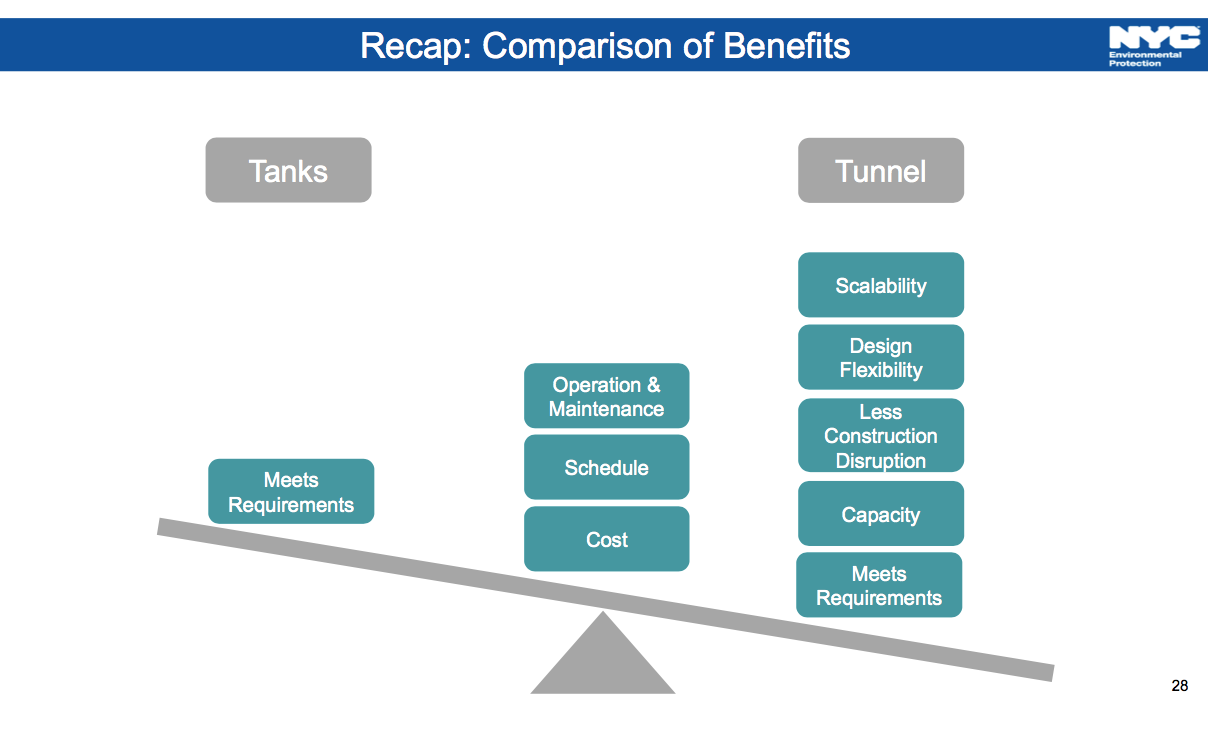
A few meeting attendees expressed suspicions about the timing of DEP’s tunnel recommendation: why wasn’t it proposed before the work on the CSO tanks began or before the property acquisitions were finalized?
Joseph Alexiou questioned DEP’s motives. Instead of going ahead with the plan that the EPA has already established, “Are we just another site to use your new project plan?” he asked Clarke. “What about what [the EPA] said four years ago, about not considering a tunnel in the case for Gowanus?” he continued. “That was a direct quote from Christos [EPA Project Manager] and you were around for those meetings. You don’t remember any of that?” Clarke said he has no memory of those claims.
Until the EPA can return to work, “DEP will continue to work on parallel tracks,” DEP Communications Director Ted Timbers told Bklyner following the meeting. The agency has met all of its milestones towards constructing the two CSO tanks and has initiated planning for the tunnel project, he noted. “We hope an EPA decision comes soon so we avoid duplicating resources.”
At the end of Tuesday’s meeting, the CAG passed a resolution calling on DEP, SHPO, and the EPA to “spare and retain in place the entirety of the two-story portion of the national historic register-eligible Gowanus Station building at 234 Butler Street if DEP and the EPA ultimately decide to pursue the CSO storage tunnel option.”




